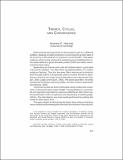Mostrar el registro sencillo del ítem
Trends, cycles, and convergence
| dc.contributor.author | Harvey, Andrew C. | |
| dc.date.accessioned | 2019-11-01T00:01:28Z | |
| dc.date.available | 2019-11-01T00:01:28Z | |
| dc.date.issued | 2002 | |
| dc.identifier.isbn | 956-7421-137 | |
| dc.identifier.uri | https://hdl.handle.net/20.500.12580/3686 | |
| dc.description | Determining turning points in the business cycle is a difficult problem. Making sensible predictions concerning the growth path of an economy in the medium or long term is even harder. This paper explores what can be achieved by analysing and modeling time series observations on gross domestic product (GDP) and other macroeconomic time series. Separating out trends and cycles is fundamental to a good deal of economic analysis. It is often done by applying filters in a rather arbitrary fashion. Thus the low-pass filter introduced by Hodrick and Prescott (1997) is frequently used to remove trends in situations in which it can create serious distortions (see Harvey and Jaeger, 1993, Cogley and Nason, 1995). The band-pass filter, recently introduced by Baxter and King (1999), can also result in distortions (see Murray, 2002). | |
| dc.format | ||
| dc.format.extent | Sección o Parte de un Documento | |
| dc.format.medium | p. 221-250 | |
| dc.language.iso | eng | |
| dc.publisher | Banco Central de Chile | |
| dc.relation.ispartof | Series on Central Banking, Analysis, and Economic Policies, no. 6 | |
| dc.rights | Attribution-NonCommercial-NoDerivs 3.0 Chile | * |
| dc.rights.uri | http://creativecommons.org/licenses/by-nc-nd/3.0/cl/ | * |
| dc.subject | CICLOS ECONÓMICOS | es_ES |
| dc.subject | DESARROLLO ECONÓMICO | es_ES |
| dc.subject | PRODUCTO INTERNO BRUTO | es_ES |
| dc.title | Trends, cycles, and convergence | |
| dc.type.doc | Artículo | |
| dc.file.name | BCCh-sbc-v06-p221_250 |


